Raupenschlepper, Ost on:
[Wikipedia]
[Google]
[Amazon]
''Raupenschlepper Ost'' (
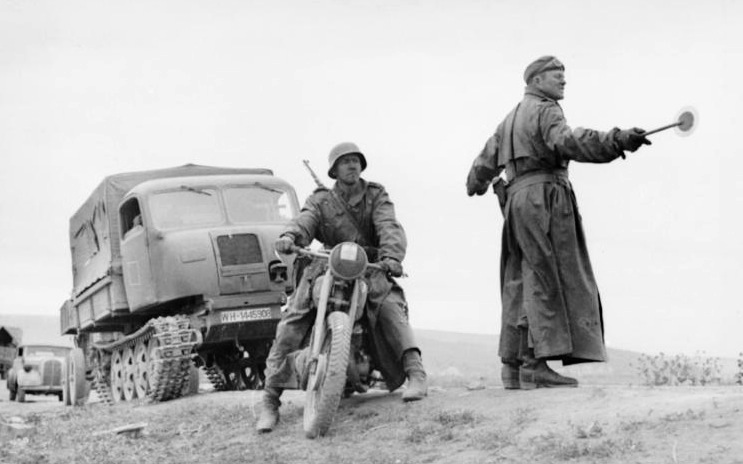
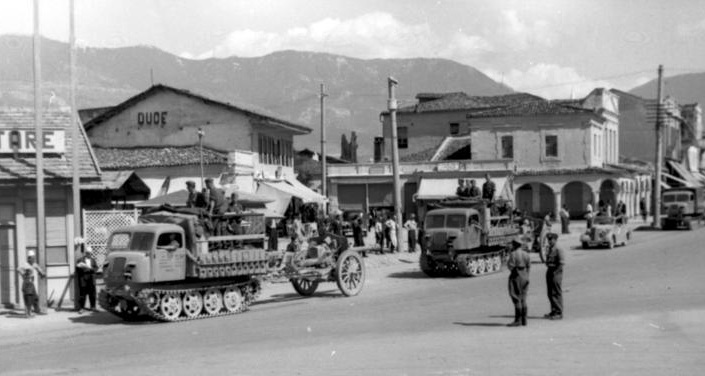 Initially designed as a prime mover and artillery supply vehicle, it eventually served in a wide variety of roles. Immediately after the vehicle reached the Eastern front, the combat units started using it for general transport duties. It gave outstanding service due to its reliability, its ease of maintenance, and its capability to take over a variety of roles - in every kind of terrain - that other vehicles lacked. The four road wheels per side, all in a single line as part of a "slack-track" system with no return rollers, comprised a much simpler suspension system, much more able to handle the
Initially designed as a prime mover and artillery supply vehicle, it eventually served in a wide variety of roles. Immediately after the vehicle reached the Eastern front, the combat units started using it for general transport duties. It gave outstanding service due to its reliability, its ease of maintenance, and its capability to take over a variety of roles - in every kind of terrain - that other vehicles lacked. The four road wheels per side, all in a single line as part of a "slack-track" system with no return rollers, comprised a much simpler suspension system, much more able to handle the

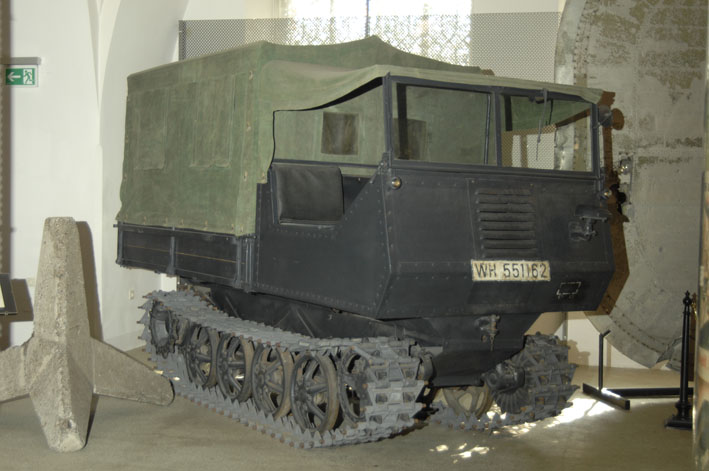 The original version had a pressed-steel cab with a truck-like configuration similar to the wheeled trucks. The next two versions – RSO/02 and 03 – had a simpler, soft-top, slab-sided metal cab. All models had wooden, drop-side cargo beds typical of
The original version had a pressed-steel cab with a truck-like configuration similar to the wheeled trucks. The next two versions – RSO/02 and 03 – had a simpler, soft-top, slab-sided metal cab. All models had wooden, drop-side cargo beds typical of
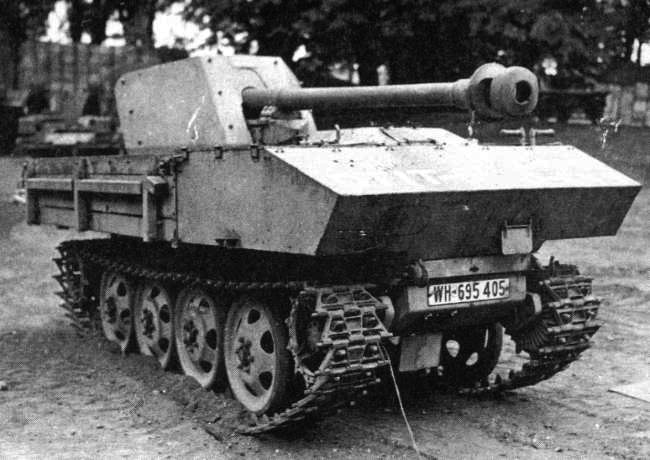
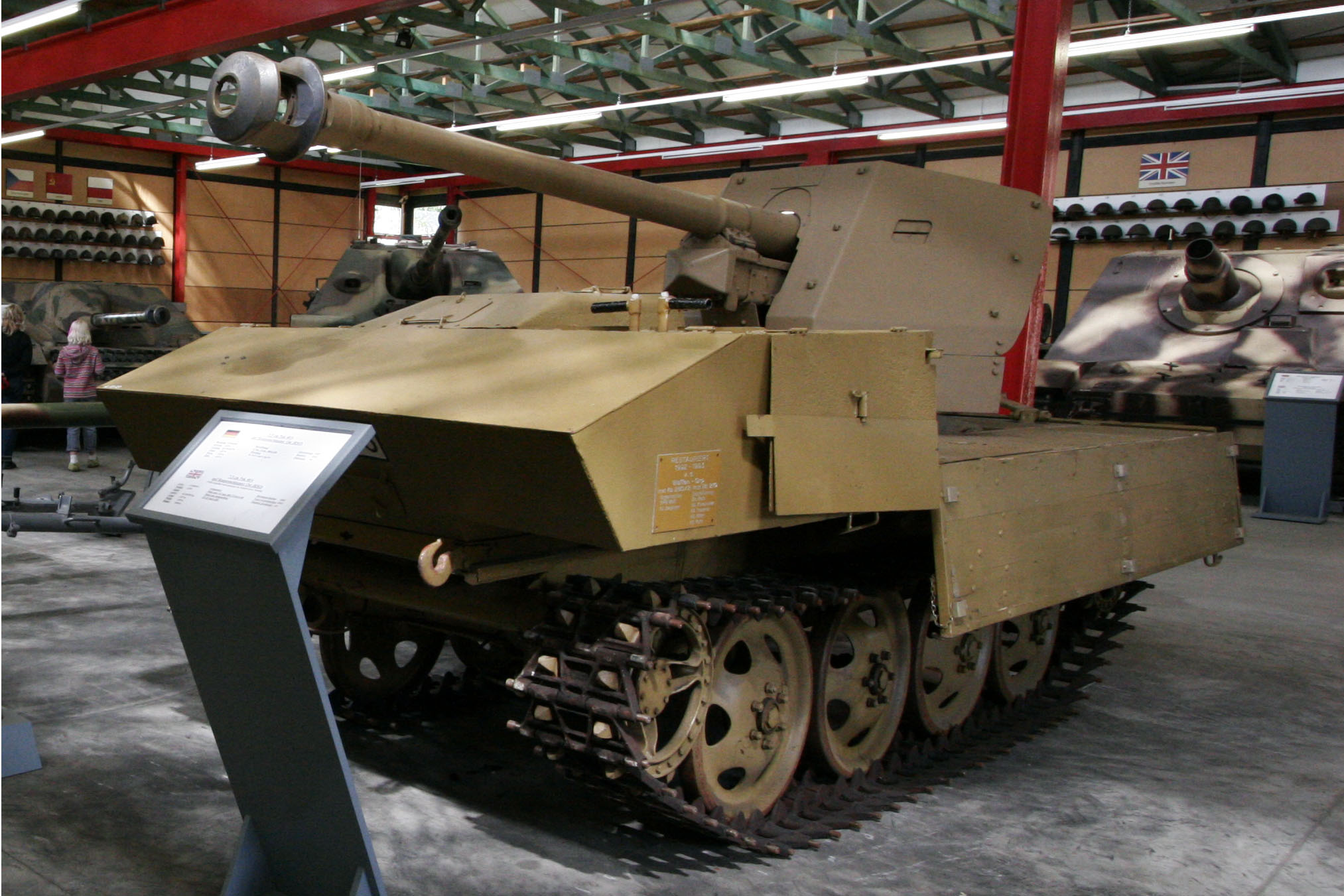 By 1943 infantry anti-tank units at the front complained strongly that it was almost impossible to move their guns using trucks at daylight under enemy fire, leading to enormous losses of equipment during "emergency relocations" (at the time a
By 1943 infantry anti-tank units at the front complained strongly that it was almost impossible to move their guns using trucks at daylight under enemy fire, leading to enormous losses of equipment during "emergency relocations" (at the time a
Raupenschlepper OST Steyr (Catalog of Enemy Ordnance
, U.S. Office of Chief of Ordnance, 1945)
{{WWIIGermanVehicles World War II vehicles of Germany Artillery tractors Military vehicles introduced from 1940 to 1944 Military vehicles of Germany
German
German(s) may refer to:
* Germany (of or related to)
** Germania (historical use)
* Germans, citizens of Germany, people of German ancestry, or native speakers of the German language
** For citizens of Germany, see also German nationality law
**Ge ...
: "Caterpillar Tractor East", more commonly abbreviated to RSO) was a fully tracked, lightweight vehicle used by the Wehrmacht
The ''Wehrmacht'' (, ) were the unified armed forces of Nazi Germany from 1935 to 1945. It consisted of the ''Heer'' (army), the ''Kriegsmarine'' (navy) and the ''Luftwaffe'' (air force). The designation "''Wehrmacht''" replaced the previous ...
in World War II
World War II or the Second World War, often abbreviated as WWII or WW2, was a world war that lasted from 1939 to 1945. It involved the vast majority of the world's countries—including all of the great powers—forming two opposin ...
. It was conceived in response to the poor performance of wheeled and half-tracked vehicles in the mud and snow during the Wehrmacht's first autumn and winter on the Soviet Front.
The RSO was a contemporary with somewhat similar Allied
An alliance is a relationship among people, groups, or states that have joined together for mutual benefit or to achieve some common purpose, whether or not explicit agreement has been worked out among them. Members of an alliance are called ...
full-tracked small artillery tractors in use in other armies (such as the Soviet STZ-5
The STZ-5 artillery tractor was a product of the Stalingrad Tractor Factory (STZ) (Russian: Сталинградский тракторный завод) from 1937 to 1942 in the Soviet Union. The tractor was designed to tow division to corps le ...
"Stalingradets", and the U.S. Army's M4 Tractor
The M4 High-Speed Tractor for World War II was an artillery tractor used by the US Army from 1943.
Design and development
The M4 High Speed Tractor used M4 Sherman tracks, roadwheels and drive sprocket.
One variant was designed to tow the 90 mm ...
), mostly originated from the pre-war light to medium series of Vickers artillery tractors.
Two variants of this vehicle were built: the basic cargo carrier, and a self-propelled antitank vehicle armed with a PaK 40
The 7.5 cm Pak 40 (''7,5 cm Panzerabwehrkanone 40 -'' "7.5cm armour defence cannon 90") was a German 75 millimetre anti-tank gun of the Second World War.
The gun was developed in 1939–1941 and entered service in 1942. With 23,303 e ...
gun. Both shared the same chassis.
Cargo carrier variant: RSO

History
After the Wehrmacht's first fall and winter (1941–1942) on the Eastern Front, they found that the extremely primitive roadways in the USSR and seasonal mud required a fully tracked supply vehicle to maintain mobility.Steyr
Steyr (; Central Bavarian: ''Steia'') is a statutory city, located in the Austrian federal state of Upper Austria. It is the administrative capital, though not part of Steyr-Land District. Steyr is Austria's 12th most populated town and the 3rd l ...
responded by proposing a small, fully tracked vehicle based upon its 1.5-tonne truck ( Steyr 1500A light truck) already in use in the army. The vehicle was introduced in 1942 as the ''Raupenschlepper Ost'' (RSO).
 Initially designed as a prime mover and artillery supply vehicle, it eventually served in a wide variety of roles. Immediately after the vehicle reached the Eastern front, the combat units started using it for general transport duties. It gave outstanding service due to its reliability, its ease of maintenance, and its capability to take over a variety of roles - in every kind of terrain - that other vehicles lacked. The four road wheels per side, all in a single line as part of a "slack-track" system with no return rollers, comprised a much simpler suspension system, much more able to handle the
Initially designed as a prime mover and artillery supply vehicle, it eventually served in a wide variety of roles. Immediately after the vehicle reached the Eastern front, the combat units started using it for general transport duties. It gave outstanding service due to its reliability, its ease of maintenance, and its capability to take over a variety of roles - in every kind of terrain - that other vehicles lacked. The four road wheels per side, all in a single line as part of a "slack-track" system with no return rollers, comprised a much simpler suspension system, much more able to handle the rasputitsa
''Rasputitsa'' ( rus, распу́тица, p=rɐsˈputʲɪtsə) is a season of the year when travel on unpaved roads or across country becomes difficult, owing to muddy conditions from rain or melting snow.
Etymology
In Russia, the term , р� ...
mud season and Russian winter
Russian Winter, sometimes personified as "General Frost" or "General Winter", is an aspect of the climate of Russia that has contributed to military failures of several invasions of Russia. Mud is a related contributing factor that impairs milit ...
conditions, without mud or snow freezing between the wheels of the complex overlapping/interleaved ''Schachtellaufwerk'' suspension systems that German half-track vehicles like the Sd.Kfz. 7
The Sd.Kfz. 7 was a half-track military vehicle used by the German Army, Luftwaffe and Waffen-SS during the Second World War. Sd.Kfz. is an abbreviation of the German word ''Sonderkraftfahrzeug'', "special purpose vehicle". A longer designati ...
possessed. Soon the orders for the RSO surpassed Steyr's production ability, and more manufacturers joined the vehicle's production in order to meet the ever increased demands.
Description

 The original version had a pressed-steel cab with a truck-like configuration similar to the wheeled trucks. The next two versions – RSO/02 and 03 – had a simpler, soft-top, slab-sided metal cab. All models had wooden, drop-side cargo beds typical of
The original version had a pressed-steel cab with a truck-like configuration similar to the wheeled trucks. The next two versions – RSO/02 and 03 – had a simpler, soft-top, slab-sided metal cab. All models had wooden, drop-side cargo beds typical of light truck
Light truck or light-duty truck is a US classification for vehicles with a gross vehicle weight up to and a payload capacity up to 4,000 pounds (1,815 kg). Similar goods vehicle classes in the European Union, Canada, Australia, and New Zealan ...
s of the era. It had a ground clearance of and was originally powered by a Steyr
Steyr (; Central Bavarian: ''Steia'') is a statutory city, located in the Austrian federal state of Upper Austria. It is the administrative capital, though not part of Steyr-Land District. Steyr is Austria's 12th most populated town and the 3rd l ...
V8 petrol engine of 3.5 L giving , which in the RSO/03 Magirus
Magirus GmbH is a truck manufacturer based in Ulm, Germany, founded by Conrad Dietrich Magirus (1824–1895). It was formerly known as Klöckner Humboldt Deutz AG, maker of the Deutz engines, so the brand commonly used was Magirus Deutz, and for ...
-produced vehicles was replaced by a Deutz air-cooled diesel engine.
The later model used a Cletrac-type final drive (instead of the automotive-type differential unit used previously) along with many other improvements. The engine was mounted on the floor of the driving cab with the drive taken through a single plate clutch to the transmission. The transmission had four forward gears and one reverse. The suspension consisted of four large pressed-steel disk wheels on each side, mounted in pairs with elliptic springs. Steering involved upright steering levers to four hydraulic brakes on the sprockets and idlers. A spring-loaded pintle
A pintle is a pin or bolt, usually inserted into a gudgeon, which is used as part of a pivot or hinge. Other applications include pintle and lunette ring for towing, and pintle pins securing casters in furniture.
Use
Pintle/gudgeon sets have ma ...
was fitted at the rear, and towing hooks were fitted in the front. It had a speed of about .
The Kingdom of Romania
The Kingdom of Romania ( ro, Regatul României) was a constitutional monarchy that existed in Romania from 13 March ( O.S.) / 25 March 1881 with the crowning of prince Karl of Hohenzollern-Sigmaringen as King Carol I (thus beginning the Romanian ...
purchased 100 RSO/01 tractors in 1943. These were used for towing anti-tank guns.Mark Axworthy, London: Arms and Armour, 1995, ''Third Axis, Fourth Ally: Romanian Armed Forces in the European War, 1941–1945'', p. 124
Anti-tank variant: RSO/PaK 40

 By 1943 infantry anti-tank units at the front complained strongly that it was almost impossible to move their guns using trucks at daylight under enemy fire, leading to enormous losses of equipment during "emergency relocations" (at the time a
By 1943 infantry anti-tank units at the front complained strongly that it was almost impossible to move their guns using trucks at daylight under enemy fire, leading to enormous losses of equipment during "emergency relocations" (at the time a euphemism
A euphemism () is an innocuous word or expression used in place of one that is deemed offensive or suggests something unpleasant. Some euphemisms are intended to amuse, while others use bland, inoffensive terms for concepts that the user wishes ...
for withdrawal), and their opinions reached the top ranks. OKW explored a previously considered proposal to fit the 7.5 cm PaK 40
The 7.5 cm Pak 40 (''7,5 cm Panzerabwehrkanone 40 -'' "7.5cm armour defence cannon 90") was a German 75 millimetre anti-tank gun of the Second World War.
The gun was developed in 1939–1941 and entered service in 1942. With 23,303 e ...
/1 anti-tank gun – by then the standard PaK used by the Wehrmacht
The ''Wehrmacht'' (, ) were the unified armed forces of Nazi Germany from 1935 to 1945. It consisted of the ''Heer'' (army), the ''Kriegsmarine'' (navy) and the ''Luftwaffe'' (air force). The designation "''Wehrmacht''" replaced the previous ...
- on top of an RSO chassis. After seeing the blueprints, Hitler ordered a limited production run for combat testing, before the prototypes were completed.
The project was carried out by Steyr. The suspension of the RSO remained unchanged, but the front driver's compartment was replaced with a low, lightly armoured superstructure. The result was a lightweight, cheap to produce, and highly mobile infantry anti-tank weapon. It was more exposed compared to the conventional, open-topped ''Panzerjäger
''Panzerjäger'' (German language, German "armour-hunters" or "tank-hunters", abbreviated to ''Pz.Jg.'' in German) was a branch of service of the Nazi Germany, German Wehrmacht during the World War II, Second World War. It was an Anti-tank war ...
'' style of tank destroyer
A tank destroyer, tank hunter, tank killer, or self-propelled anti-tank gun is a type of armoured fighting vehicle, armed with a direct fire artillery gun or missile launcher, designed specifically to engage and destroy enemy tanks, often wi ...
, which had a construction cost many times that of a RSO/PaK 40.
Although the vehicle was intended for use by the infantry anti-tank units, all pre-production vehicles were issued to armoured units (''Panzerjager Abteilungen'' 743 and 744, and 18th ''Panzergrenadier
''Panzergrenadier'' (), abbreviated as ''PzG'' (WWII) or ''PzGren'' (modern), meaning '' "Armour"-ed fighting vehicle "Grenadier"'', is a German term for mechanized infantry units of armoured forces who specialize in fighting from and in conjunc ...
'' Division), due to the urgent need for replacements. Their low speed and light armour inevitably resulted in problems for these units trying to cooperate with those in other fighting vehicles. The German Army Group South
Army Group South (german: Heeresgruppe Süd) was the name of three German Army Groups during World War II.
It was first used in the 1939 September Campaign, along with Army Group North to invade Poland. In the invasion of Poland Army Group Sou ...
, where the units issued for combat testing, declared the vehicle useful, and large-scale production was quickly authorised.
Despite the decision to have Steyr shift its entire production line to the RSO/PaK 40, no specific order arrived, and only the approximately 60 pre-production vehicles were ever manufactured. While the first vehicles were rolled out from the production line, Steyr started testing an improved version that incorporated a wider chassis and tracks; these changes improved cross-country performance and lowered the center of gravity, a problem in a vehicle of such a high ground clearance.
None of the improved version ever reached the front. In October 1943, Steyr was ordered by the Ministry of Munitions to cease production of any type of tracked vehicles. By then a new up-gunned version of the widened chassis had been designed and was planned to enter production in 1944; it had a more powerful and less noisy V8 petrol engine to carry the 88 mm PaK 43
The Pak 43 (''Panzerabwehrkanone 43'' and ''Panzerjägerkanone 43'') was a German 88 mm anti-tank gun developed by Krupp in competition with the Rheinmetall 8.8 cm Flak 41 anti-aircraft gun and used during World War II. The Pak 43 was the ...
L71 gun, by far the most powerful anti-tank weapon of its era designated ''Pz.Jäg.'' K43. It is doubtful any were constructed by the end of the war.
Production
Approximately 23,000 RSO of all versions were produced by Steyr (2,600 pcs), Klöckner-Humboldt-Deutz AG (KHD; 12,500 pcs),Auto Union
Auto Union AG, was an amalgamation of four German automobile manufacturers, founded in 1932 and established in 1936 in Chemnitz, Saxony. It is the immediate predecessor of Audi as it is known today.
As well as acting as an umbrella firm f ...
's Siegmar plant (former Wanderer
Wanderer, Wanderers, or The Wanderer may refer to:
* Nomadism, Nomadic and/or itinerant people, working short-term before moving to other locations, who wander from place to place with no permanent home, or are vagrancy (people), vagrant
* The Wan ...
; 5,600 pcs) and Gräf & Stift
Gräf & Stift was an Austrian manufacturer of automobiles, trucks, buses and trolleybuses, from 1902 until 2001, latterly as a subsidiary of MAN. It was founded in 1902 by the brothers Franz, Heinrich and Karl Gräf, and the investor, Wilhelm S ...
(4,500 pcs).
See also
* The 21st centuryBandvagn 206
Bandvagn 206 (Bv 206) (meaning ''"Tracked Vehicle 206"'' in English) is a tracked articulated, all-terrain carrier developed by Hägglunds (now part of BAE Systems Platforms & Services) for the Swedish Army. It consists of two units, with all f ...
, used in Europe and the Americas
* M29 Weasel
The M29 Weasel is a World War II tracked vehicle designed for operation in snow. Built by Studebaker, Weasels were also used in sandy, muddy, and desert terrains, including towing loads over terrain wheeled vehicles could not negotiate as in the ...
* ''Schwerer Wehrmachtschlepper
The ''Schwerer Wehrmachtschlepper'' (sWS; "Heavy Military Tractor") was a German World War II half-track vehicle used in various roles between 1943 and 1945. The unarmored models were used as supply vehicles and as tractors to haul artillery. Armo ...
''
* '' Sd.Kfz. 4''
* Universal Carrier
The Universal Carrier, also known as the Bren Gun Carrier and sometimes simply the Bren Carrier from the light machine gun armament, is a common name describing a family of light armoured tracked vehicles built by Vickers-Armstrongs and other ...
* C2P tractor
* Renault UE
The Renault UE Chenillette is a light tracked armoured carrier and prime mover produced by France between 1932 and 1940.
In 1930 the French Infantry decided to develop a light armoured vehicle able to tow and supply small cannon and mortars. I ...
* M4 Tractor
References
Notes
Bibliography
External links
Raupenschlepper OST Steyr (Catalog of Enemy Ordnance
, U.S. Office of Chief of Ordnance, 1945)
{{WWIIGermanVehicles World War II vehicles of Germany Artillery tractors Military vehicles introduced from 1940 to 1944 Military vehicles of Germany